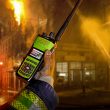DHS demonstrates new firefighter-tracking system
Incident commanders soon could have a new tool that will allow them to track and send aid to firefighters who may been in danger while working in locations that have little or no visibility, thanks to a solution demonstrated today by the U.S. Department of Homeland Security (DHS).
Known as the Geospatial Location Accountability and Navigation System for Emergency Responders (GLANSER), the solution developed by Honeywell leverages a variety of location-based technologies to address what long has been a significant challenge in the first-responder sector—tracking personnel inside buildings, where GPS is ineffective. Not only does GLANSER work inside buildings from a typical two-dimensional standpoint, it also provides altitude perspective that allows tracking from one floor to another.
“It worked very well—the GLANSER technology is right where we expected it to be,” John Sullivan, deputy chief of the Worchester (Mass.) Fire Department, said during an interview with Urgent Communications. “The advancements in the communication pieces and the ability to track on that third dimension have truly advanced a long way, to the point where we’re pretty confident in the technology and being able to use it.
“And, as you know, in the fire service, having confidence in the technology is huge.”
Conducted at the Worcester Polytechnic Institute, and sponsored by the DHS science and technology directorate, the demonstration called for the tracking of firefighters in two realistic scenarios—one in a man-down situation, and another where a crew became separated on different floors, Sullivan said.
“That’s huge—that’s the big piece for us, the ability to see it in that third dimension,” he said. “That ability to get that third-dimensional view of the building is truly the difference maker in this technology.”
Today’s demonstration was conducted without any active participation from DHS engineers, according to Jalal Mapar, program manager for the science and technology directorate. The fact that firefighters were able to use the system without technical assistance was significant, he said.
“This was a big day for the program,” Mapar said during an interview with Urgent Communications. “The biggest thing that you can ask for is not for us to say that it works, but for the user community … to come and say, ‘Wow.’ And those were exactly their words.”
The first version of the GLANSER system could be available for use in six or seven months, Mapar said.

















